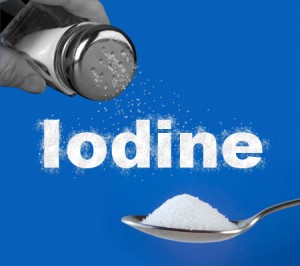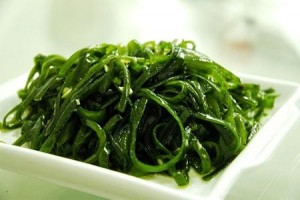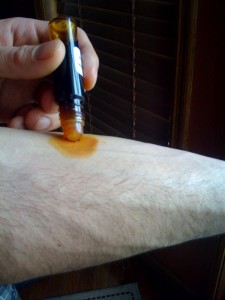5 Ways to Protect Yourself from Iodine Toxicity
Written by Tom Brimeyer | Posted in Diet & Nutrition | 13 Comments
 There’s no denying the fact that iodine has become a popular treatment method for hypothyroidism today. And rightfully so, considering that most websites discussing the topic of hypothyroidism bombard you with advertisements for the latest and greatest iodine supplements that are sure to cure your hypothyroidism.
There’s no denying the fact that iodine has become a popular treatment method for hypothyroidism today. And rightfully so, considering that most websites discussing the topic of hypothyroidism bombard you with advertisements for the latest and greatest iodine supplements that are sure to cure your hypothyroidism.
But have you ever stopped to question the safety or legitimacy behind saturating your body with unnatural amounts of iodine?
The popularity behind the use of iodine for hypothyroidism has been largely fueled by iodine’s use, centuries ago, in the treatment of goiters. This, along with other false beliefs regarding your body’s need for iodine, has led some practitioners to recommend that you saturate yourself with iodine, because of the ridiculous belief that more is always better.
Unfortunately, the only ones who win are those selling iodine supplements because the more you use, the more money they make.
Iodine toxicity is a bigger problem than most people realize. I recently discussed some of the specific dangers of iodine toxicity related directly to thyroid function in my blog post 3 Dangers of Iodine Therapy for Hypothyroidism.
How Much Iodine Are You Getting?
Of course, there is a lot of variation from person to person with respect to the amount of iodine people consume on average per day. There are certainly some people who are truly deficient in iodine although this is quite rare today.
Seeing as how the recommendation for iodine is currently 150 mcg per day, it should be easy to understand how one can effortlessly achieve the recommended amount.
Below are a list of some common foods and their iodine content which can give you a better idea of how much iodine you are getting in your diet:
|
Iodine Content in Foods |
||
| Food |
Serving |
Iodine |
| Meat | 3 oz. | 15 mcg |
| Shellfish | 3 oz. | 21 – 37 mcg |
| Cod | 3 oz. | 99 mcg |
| Milk | 8 oz. | 58 – 116 mcg |
| Eggs | 1 large | 18 – 29 mcg |
| Potatoes | 1 medium | 60 mcg |
| Iodized Salt | ¼ tsp. | 115 mcg |
| Seaweed | 1 oz. | 18,000 mcg |
Getting enough iodine in your diet is oftentimes achievable in a single meal. A single serving of fish with a potato alone can provide you more than enough iodine in a single serving. This is without the inclusion of additional sources of iodine that most people are exposed to on a daily basis such as iodized salt.
How to Protect Yourself from Iodine Toxicity
Below are some simple guidelines to help you protect yourself from the negative effects of excess iodine.
1. Avoid Iodine Supplements
To give you an idea of the potency of many iodine supplements today, most people are using 12.5 mg to 100 mg of iodine daily, which equals 80 to 650 times the recommend daily allowance.
To put that into perspective, there are some studies that demonstrate the toxic effects of even a small excess of iodine, from as little as 1 mg.
If you suspect an iodine deficiency then it’s important to use proper testing to determine this prior to diagnosing yourself based solely on assumptions. Measuring your iodine intake as well as testing your urine to determine how much iodine is being excreted is one way to measure your potential for deficiency or toxicity.
Blindly taking iodine supplements puts you at a much greater risk of iodine toxicity which can further damage your thyroid and oftentimes contributes to the development of autoimmune thyroiditis.
2. Avoid Iodized Salt
 During the mid to late 1800’s iodized salt was beginning to be used to reduce the prevalence of goiters in many countries. During that time, iodine deficiency was a much bigger issue. But as you can see by simply looking at the table above, referencing the iodine content found in common foods today, iodine deficiency is not as common you as might think.
During the mid to late 1800’s iodized salt was beginning to be used to reduce the prevalence of goiters in many countries. During that time, iodine deficiency was a much bigger issue. But as you can see by simply looking at the table above, referencing the iodine content found in common foods today, iodine deficiency is not as common you as might think.
Seeing as how as little as ¼ tsp. of iodized salt provides almost your entire recommended daily allowance of iodine, it should be easy to see how the use of iodized salt can have quite the dramatic effect on your daily iodine intake.
It is also well known that hypothyroid sufferers lose sodium rapidly through their urine. Because of this, their need for salt (sodium) increases which only further compounds this problem and increases your risk of iodine toxicity.
Because of this, it is advisable to get your iodine from other dietary sources and to avoid iodized salt altogether.
3. Avoid Seaweed and Other Excessive Sources of Iodine
 The idea that seaweed, kelp, and other sea vegetables are rich in thyroid and therefore must be healthy for your thyroid has led many to label iodine-rich foods like seaweed as super-foods.
The idea that seaweed, kelp, and other sea vegetables are rich in thyroid and therefore must be healthy for your thyroid has led many to label iodine-rich foods like seaweed as super-foods.
But the extremely high iodine content can quickly become counter-production. Many types of seaweed provide as much as 4,500 mcg of iodine per ¼ oz., which is 30 times more than the recommended daily allowance.
4. Focus on Natural Foods that Contain Healthy Amounts of Iodine
The easiest way to avoid iodine toxicity is to simply focus on eating a naturally healthy diet that contains healthy amounts of iodine.
However, the topic of a truly healthy diet is quite complex as there are many other factors aside from iodine content that are important in overcoming hypothyroidism.
These dietary factors, along with a step by step plan on how to heal your thyroid, are discussed in detail in my Hypothyroidism Revolution Program.
5. Don’t Fall for Un-Scientific Testing
 Many practitioners who support using high doses of iodine for hypothyroidism also push various tests to determine your potential for iodine deficiency, most of which have been proven to be scientifically invalid.
Many practitioners who support using high doses of iodine for hypothyroidism also push various tests to determine your potential for iodine deficiency, most of which have been proven to be scientifically invalid.
One such unscientific test that has gained popularity is the iodine spot test. The claim is that you can tell if you are iodine deficient by painting a spot of iodine on your skin. If it disappears quickly then this is believed to be a sign of deficiency.
However, this test holds no scientific basis. Iodine can quickly be converted into colorless iodide through its interaction with many substances.
The bottom line is, avoiding iodine supplements, iodized salt, and other foods that are abnormally high in iodine is a necessary and important step in avoiding iodine toxicity and properly regulating thyroid function. Of course there is always the possibility that you could truly be iodine deficient and if you do suspect this, then do yourself a favor and get the proper testing you need to be properly diagnosed. Blindly taking an iodine supplement, or any other supplement for that matter, is an accident waiting to happen.












Gina Reed
14. Jun, 2012
Thank you for the specific data on the iodine content of fish/potatoes and other staples in this diet.
Dave
14. Jun, 2012
Iodine can be rubbed on feet and you will only asorb what you need. This is helpful for people who have problems asorbing iodine.
There is muscle testing you can do to check for the proper dosing. This is done by a acupuncturist.
Tom Brimeyer
14. Jun, 2012
Unfortunately this is NOT true. I would recommend finding a new acupuncturist. 🙂
Denise Strickland
14. Jun, 2012
Thank you for this info.My Dr recently sold me a bottle of iodine supp. 2.5mg per day.I haven,t opened it,I was unsure about taking it.NOW I AM SURE I WON,T. Thank you again Tom
Doris Huling
14. Jun, 2012
Thank you for this information, about iodine. I’m quite sure I have been getting too much.
Susan
14. Jun, 2012
I have been taking a liquid sea vegetable solution for years and I just stopped.
Dave
15. Jun, 2012
Tom what are saying is untrue? The muscle testing or the asorbing on the feet. The muscle testing will work for anything that may be ingested. It will check for tolerance for meds and food. They been doing this for 5000 years and it does work. I would like to test you. Lol
In one of your pages you recomend morton pickeling salt. I would like to sugest using celtic sea salt instead. Celtic sea salt has about 90 diferent elements in it in balance. NOT SEA SALT..this has been processed. When salt is processed it is not balanced the sodium and iodine are not balanced. That is why it causes high nlood pressure in some.
Dave
Tom Brimeyer
15. Jun, 2012
@Dave, I wasn’t referring to muscle testing. I was referring the idea that your feet will only absorb what you need. That is quite “unscientific”. I’m not against muscle testing either but know what the research says and understand that it is practitioner specific. I’ve had a lot of experience with muscle testing.
Yes, sea salt contains some iodine, but sea salt needs to be avoided because it contains iron and there is quite a lot of research on the toxicity of iron.
The idea of sodium and iodine not being balanced as the cause of high blood pressure… extremely “unscientific”.
Not sure where you’re getting your info but please send research to support it.
Dave
15. Jun, 2012
Tom, i would recomend the book Chemistry Of Man by Benard Jensen. The works of Dr. Benard Jensen and VG Rocine, his teacher, reveal not only the intimate association between foods and health, but also the role of the chemical elements in the shaping of the human temperament. Dr. Benard worked with patients for over 50 years at his sanitariums, he observed remarkable changes for the better of his patients, elimination, tissue cleaning, rejuvenation, and well being.
His science was done by going to over 55 countries and study their lifestyles and habits. Though his studies he has aquiredfor the care, reversal and prevention of disease.
HAPPY READING!
PS. where do you get your scientific data?
Tom Brimeyer
15. Jun, 2012
Send me studies regarding the iodine absorption and sodium to iodine balance.
My research comes from published medical and scientific journals. Check out some of my other posts. Cheers.
Ola Lachney
15. Jun, 2012
I agree with you because I personally experienced the toxic effects of taking Kelp along with my thyroid med. My doc. said it couldn’t hurt. It did hurt ! It caused me to be more ill and the doc. changed my thyroid med to a lower level instead of saying,”stop the Kelp”. I stopped the kelp and then,of course, needed help with my thyroid med again.
I didn’t know about all the iodine in these foods you listed. Thank You!
Dave
17. Jun, 2012
Tom, there is no scientific research data on the absorbing of idoine though the feet from Dr. Bernard, only that he states that he used the treatment in his sanatariums with success.
But I did find this recent summary from a Dr. David Perricone dated January 2011.
There is no simple blanket “yes” or “no” answer to the question about what does or does not get through the skin. I have a Ph.D. in human physiology, and I’ve consulted on trans-dermal delivery systems for “natural” health products, so I have an extensive background in both the theory and real world applications of what does and does not cross the skin and how. The short answer is, “It depends – some things do cross the skin, some things do not. And some things that don’t “usually” cross the skin can cross under certain conditions, such as carrier molecules or nano-particle encapsulation.”
What crosses or does not cross the skin depends on many factors, such as which chemicals, which compounds, the condition of the skin and physiology, individual variances, etc. To be relatively brief and simple, without writing a book or even short paper on the topic, the “simple” fact you MUST consider is that skin is VERY complex, and has both active transport as well as passive diffusion of various chemicals and compounds across the skin – in both directions. In addition to what will naturally cross or not cross the skin, various “carrier” and/or permeability compounds can be included in a product formulation to increase (or decrease) the amount and rate of trans-dermal “delivery” of various substances through the skin. Some things will cross the skin on their own, some will cross with various carriers (passive or active), and some things are impossible (with current technology – never say never!) to get across the skin and into the body. Some areas of skin are easier to cross than others, depending on how thick the skin is – the “keratizined epithelium” on the soles of your feet (particularly if you go barefoot a lot) or even your hands (particularly if you do manual labor) is a lot thicker (and more resistant to “things” crossing it) than your lips (and for those who might be confused, yes, the outer part of your lips are considered skin (“keratizined epithelium”) to the line where your lips touch when your mouth is closed. Inside that line is considered “mucosa” or mucous membrane. But the skin is very thin on the lips, and that’s one reason why whatever goes on your lips should be of more concern than what goes on other areas of your skin. Plus it is a very short distance from lip skin to the mucosa of the mouth, where what crosses into your body and at what rate can be very different than on skin. And from the mouth of course it is easy to get into the “stomach” – the whole gastrointestinal tract – or into the lungs – with very different set of variables determining what gets into your body or not!
(BTW, a small side note for the person who asked about inhaling salt in a peanut factory, and a significant factor for everyone to consider: the lungs are structured to be permeable, so if salt dust – or any other dust or aerosol – is being inhaled into the lungs, significant absorption MAY (again, depending on what it is) occur that way. For salt, I have not looked for any studies on that, but based on general physiology and biochemistry, it would be very likely for inhaled salt dust to be absorbed in the lungs. Also, for everyone, a comment was made about concern over inhalation of chlorine from showers – this is also a significant factor, and many people may absorb more chlorine (and other toxic chlorine by-products) from their shower in chlorinated water than from drinking chlorinated water! The is also a growing concern that many cleaning solutions may be inhaled and absorbed through the lungs, particularly when applied with spray bottles or cans. This is a becoming a significant issue in hospitals, with their frequent cleaning, particularly with disinfectants – which are intentionally toxic to “germs” but are also often toxic and/or allergenic to people too, particularly with frequent exposure! So if you are concerned about the toxins you may be exposed to and that you may be absorbing, check out the ingredients of your shower water and your cleaning products as well as your “personal care” products. Now back to the main topic here of absorption through the skin…)
Even if something gets through (instead of just into) the skin, “it depends” on many more factors if that substance gets to other locations in the body. And “it depends” on what the substance(s) is/are as to what it does or does not do in the body. Some things are very reactive in the body, some things are inert. It (“it” varies a lot, and what happens varies a lot depending on what “it” is) may just stay in the sub-dermal tissue(s) (just below the skin) immediately adjacent to the application site. “It” may just passively diffuse across the skin and throughout the body. “It” may get into the blood or lymph system. It may circulate throughout the body for a prolonged time, or be broken down or converted or excreted on its first pass through the liver, kidneys, or other organs. And in the body, a substance may be converted into something else that is more or less nourishing or more or less toxic to the body. The complexity goes on and on. Individuals vary, between people and even in one person over time. As extreme examples of individual variability, just think of the growing number of people who are sensitive or even lethally allergic to peanuts, shellfish, wheat, eggs, etc. Most of those people did not start out sensitive or allergic, but became so over time. It is becoming more and more clear that the body (with significant individual variability) can only handle a certain amount of stress / toxic load for so long, and them starts to break down in its ability to handle the stress / toxic load. What you could handle at one point in your life / environment, you may not be able to handle at another time and/or place.
So the simple answer is, “There is no simple answer! What gets through the skin – and what it does if it gets through – depends on what the substance is, where and how it is applied, and even to whom it is applied. And the situation gets rapidly more complex when there is more than one substance in combination, and when you consider that individual people vary in their sensitivities, with variances both between people and also in one individual over time!”
Be well, Be Blessed and most of all, Enjoy!
Ps. Tom I do apreciate your hypothyroid research. You have a lot of great ideas that we are implementing with my grandson.
syd r
14. Jun, 2014
thanks a lot